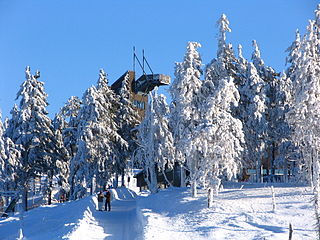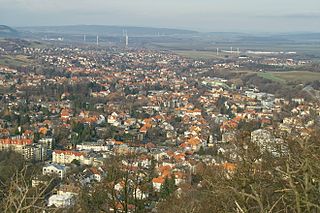
The Oker is a river in Lower Saxony, Germany, that has historically formed an important political boundary. It is a left tributary of the River Aller, 128 kilometres (80 mi) in length and runs in a generally northerly direction.
Wolfenbüttel is a district in southeastern Lower Saxony, Germany. Neighboring districts are the district-free City of Braunschweig, the district of Helmstedt, the district of Harz in Saxony-Anhalt, and the districts of Goslar, Hildesheim and Peine. The district-free city of Salzgitter cuts through the district of Wolfenbüttel in the southwest.

Goslar is a district in Lower Saxony, Germany. It is bounded by the districts of Göttingen, Northeim, Hildesheim and Wolfenbüttel, the city of Salzgitter, and by the states of Saxony-Anhalt and Thuringia (Nordhausen).

The Principality of Calenberg was a dynastic division of the Welf Duchy of Brunswick-Lüneburg established in 1432. Calenberg was ruled by the House of Hanover from 1635 onwards; the princes received the ninth electoral dignity of the Holy Roman Empire in 1692. Their territory became the nucleus of the Electorate of Hanover, ruled in personal union with the Kingdom of Great Britain from 1714 onwards. The principality received its name from Calenberg Castle, a residence of the Brunswick dukes.

The Duchy of Brunswick was a historical German state that ceased to exist in 1918. Its capital was the city of Brunswick. It was established as the successor state of the Principality of Brunswick-Wolfenbüttel by the Congress of Vienna in 1815. In the course of the 19th-century history of Germany, the duchy was part of the German Confederation, the North German Confederation and from 1871 the German Empire. It was disestablished after the end of World War I, its territory incorporated into the Weimar Republic as the Free State of Brunswick.

Bad Harzburg is a spa town in central Germany, in the Goslar district of Lower Saxony. It lies on the northern edge of the Harz mountains and is a recognised saltwater spa and climatic health resort.

Ilsenburg is a town in the district of Harz, in Saxony-Anhalt in Germany. It is situated under the north foot of the Harz Mountains, at the entrance to the Ilse valley with its little river, the Ilse, a tributary of the Oker, about six 6 miles (9.7 km) north-west of the town of Wernigerode. It received town privileges in 1959. Owing to its surrounding of forests and mountains as well as its position on the edge of the Harz National Park, Ilsenburg is a popular tourist resort. Since 2002, it is officially an air spa.

Ringelheim is the sixth biggest quarter of Salzgitter in Lower Saxony, Germany. It is located on the Innerste River at the very far south-western end of the urban area, and has a population of 1,994. The Salzgitter-Ringelheim train station is the most important station of the city, as the Brunswick Southern Railway and the line from Hildesheim to Goslar cross here.

Liebenburg is a municipality in the district of Goslar, in Lower Saxony, Germany.

Henry V of Brunswick-Wolfenbüttel, called the Younger,, a member of the House of Welf, was Duke of Brunswick-Lüneburg and ruling Prince of Brunswick-Wolfenbüttel from 1514 until his death. The last Catholic of the Welf princes, he was known for the large number of wars in which he was involved and for the long-standing affair with his mistress Eva von Trott.

Dorstadt is a municipality in the district of Wolfenbüttel, in Lower Saxony, Germany. It is part of the Samtgemeinde Oderwald.
Werlaburgdorf is a village and a former municipality in the district of Wolfenbüttel, Lower Saxony, Germany. Since 1 November 2013, it is part of the municipality Schladen-Werla.

The Prince-Bishopric of Hildesheim was an ecclesiastical principality of the Holy Roman Empire from the Middle Ages until its dissolution in 1803. The Prince-Bishopric must not be confused with the Diocese of Hildesheim, which was larger and over which the prince-bishop exercised only the spiritual authority of an ordinary bishop.

The Hildesheim Diocesan Feud or Great Diocesan Feud, sometimes referred to as a "chapter feud", was a conflict that broke out in 1519 between the Prince-Bishopric of Hildesheim and the principalities of Brunswick-Wolfenbüttel and Calenberg that were ruled by the House of Welf. Originally just a local conflict between the Hildesheim prince-bishop John IV of Saxe-Lauenburg and his own prince-bishopric's nobility (Stiftsadel), it developed into a major dispute between various Lower Saxon territorial princes. The cause was the attempt by Prince-Bishop John to redeem the pledged estates and their tax revenue from the nobles in his temporalities, the prince-bishopric. The diocesan feud ended with the Treaty of Quedlinburg in 1523.

The Brunswick–Bad Harzburg railway is a 47 km long German main line railway in the northern foothills of the Harz. It is one of the oldest lines in Germany and the first government-owned railway in Germany.

Oker is a borough (Stadtteil) of Goslar in Lower Saxony, Germany. Since 1952 a mining town in its own right within Wolfenbüttel district, it was incorporated into the Goslar municipality on 1 July 1972.

The Harly Forest is a hill range up to 256 m (840 ft) above NN in the district of Goslar in southeastern Lower Saxony, Germany.

The Harliburg is a former imperial castle (Reichsburg) in the Harly Forest, in southeast Lower Saxony, Germany.

The Hildesheim–Goslar railway is a 53 kilometre long, double-track and non-electrified main line in the northern Harz foothills in the German state of Lower Saxony. It serves mainly to connect with the tourist region in the northern Harz with Hildesheim and Hanover. It is served by the HarzExpress, running between Halle, Halberstadt, Goslar and Hannover Hauptbahnhof. The most important station and junction of the line is Salzgitter-Ringelheim station.

Bad Harzburg railway station serves the spa town of Bad Harzburg in Lower Saxony, Germany. It is the southern terminus of the Brunswick–Bad Harzburg railway, one of the oldest lines in Germany, and the eastern terminus of a branch line to nearby Oker station. Regional rail services are operated by Deutsche Bahn AG and Erixx GmbH.























